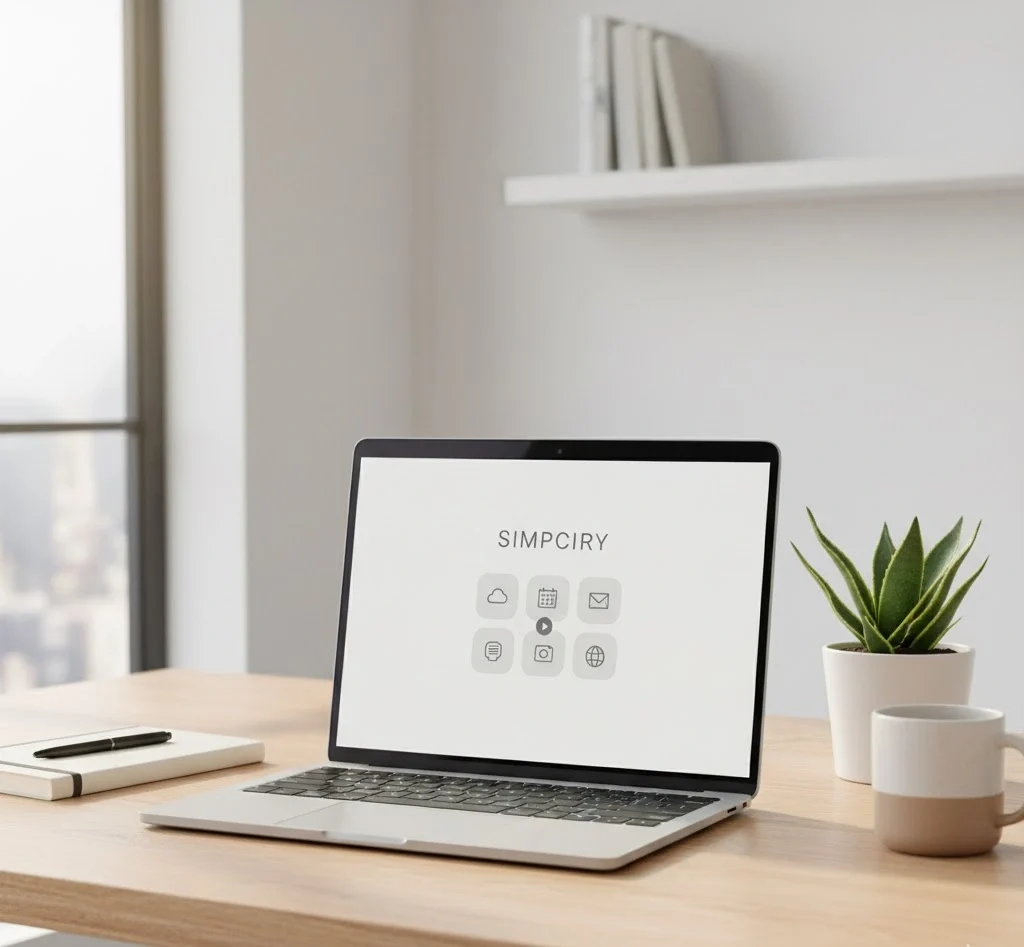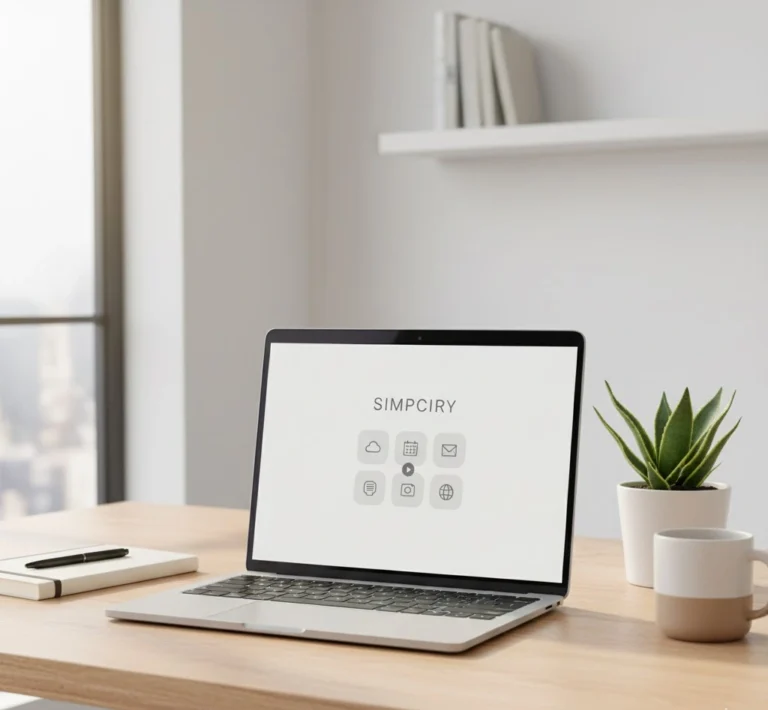
Three months ago, I found myself staring at my phone screen at 2 AM, mindlessly scrolling through my seventh social media app of the night. I had 47 browser tabs open on my laptop, 12,000 unread emails, and a desktop so cluttered I couldn’t find the file I’d saved just hours earlier. That’s when I realized something had to change.
What I discovered changed everything. It wasn’t another productivity hack or time management system. It was simpciry a philosophy that helped me reclaim my digital life and, honestly, my sanity.
What Simpciry Really Means
Simpciry blends the concepts of simplicity and clarity into one powerful approach to modern living. It’s not just about having less stuff or a minimalist aesthetic. Think of simpciry as your guide through the overwhelming digital landscape we all navigate daily.
When I first heard the term, I thought it was a typo. Turns out, that’s exactly the point. Simpciry deliberately breaks from traditional “simplicity” to represent something fresh a modern movement born from our collective digital exhaustion. It’s about making intentional choices that reduce noise and increase focus.
The philosophy emerged from design communities frustrated with feature-bloated apps and overwhelming interfaces. But simpciry quickly spread beyond tech circles. Today, it’s reshaping how people approach everything from their morning routines to their business strategies.
Why Digital Chaos Is Crushing Us
Here’s what nobody talks about: the average person encounters over 6,000 marketing messages every single day. We’re drowning in notifications, updates, and endless content streams. Our brains weren’t designed for this level of stimulation.
I experienced this firsthand when I tracked my phone usage for a week. The results shocked me, I was picking up my device 89 times daily, spending nearly 5 hours on it. Most of that time? Completely mindless. I’d open apps without knowing why, scroll without purpose, and close them feeling emptier than before.
Research shows this constant digital multitasking increases stress levels and decreases our ability to focus. We’re always “on,” always available, always consuming. The mental load is exhausting.
Simpciry addresses this crisis head-on. Instead of adding another app or system to manage the chaos, it helps you eliminate the sources of overwhelm at their root.
The Core Philosophy Behind Simpciry
What makes simpciry different from traditional minimalism? Three fundamental principles guide everything:
Clarity without compromise means your digital spaces should make sense instantly. When I redesigned my workspace using simpciry principles, I removed 70% of the visual elements. What remained? Only the tools and information I actually used daily. The difference was remarkable decisions became faster, stress dropped noticeably.
Intentional technology use shifts your relationship with digital tools. Instead of technology controlling your attention, you control how and when you engage. I now use apps as tools, not entertainment. My smartphone serves a purpose rather than stealing my time.
Purposeful simplification focuses on keeping what adds value while removing everything else. This isn’t about deprivation it’s about making space for what matters. When I applied this to my email inbox, I went from 12,000 messages to 47. The relief was immediate and lasting.
These principles work together, creating a framework that adapts to your specific needs and circumstances.
How Simpciry Transforms Digital Design
Simpciry has been a game changer in digital design. Simple and clean designs are not only more aesthetically pleasing but also better in terms of usability. Users interacting with a simpciry – designed platform finish off quicker and have a better experience overall.
To put this into practice, I ranked my experience of two productivity apps. One featured all the imaginable utilities timers, trackers, charts, social elements, gamification, themes, etc. Meanwhile, the other one was built according to the principles of simpciry with only three basic functions. Can you guess which one I used regularly? The simpler option every time.
Visual clutter creates cognitive load. Your brain works harder to process busy layouts, competing colors, and unclear navigation. Simpciry-driven design eliminates this friction by prioritizing clean layouts, harmonious colors, and intuitive navigation. Everything has a purpose. Nothing distracts.
Mobile experiences especially benefit from simpciry. With limited screen space, every pixel matters. Apps built on simpciry principles feel effortless you tap once instead of three times, find features immediately, and accomplish goals without frustration.
Applying Simpciry to Your Daily Life
Transforming your life with simpciry starts with small, manageable changes. I didn’t overhaul everything overnight. Instead, I tackled one area at a time, building momentum gradually.
Digital decluttering was my starting point. I deleted apps I hadn’t used in 30 days that alone removed 47 apps from my phone. Then I turned off notifications for everything except texts and calls from actual humans. The constant buzzing stopped, and with it, the anxiety of feeling perpetually behind.
My home screen now contains exactly seven apps: phone, messages, calendar, maps, music, camera, and notes. Everything else lives in folders I access intentionally, not reflexively. This simple change reduced my daily phone time by nearly 40%.
Financial simplification came next. I consolidated three bank accounts into one, automated bill payments, and set up simple budgeting rules through my banking app. Managing money went from a weekly stress-fest to a monthly 15-minute review.
Workspace design following simpciry principles doubled my productivity. I removed everything from my desk except my laptop, a notebook, and one pen. Decorations, trinkets, extra screens all gone. My focus improved dramatically because there was literally nothing else to look at.
The key insight? Simpciry isn’t about rules or rigid systems. It’s about designing your environment to support the life you want to live.
Simpciry in Professional Settings
Businesses adopting simpciry see measurable results. Higher conversion rates, increased customer satisfaction, and improved employee productivity the benefits are concrete and significant.
When I helped a client redesign their e-commerce checkout process using simpciry principles, we reduced it from seven steps to three. Cart abandonment dropped 34% within the first month. Customers weren’t leaving because they got frustrated or confused the path to purchase became obvious and frictionless.
Company communication improves with simpciry too. I implemented a policy at my previous job: emails could contain only one request or topic. No more endless threads discussing twelve different issues. Response times cut in half, and misunderstandings nearly disappeared.
Meetings became more effective when we applied simpciry. Instead of hour-long status updates where everyone multitasks, we scheduled 15-minute focused discussions with clear agendas. Attendance improved because people knew their time wouldn’t be wasted.
The results speak for themselves: higher conversions, increased loyalty, and reduced bounce rates. When businesses respect users’ time and mental energy, those users respond positively.
The Psychology That Makes Simpciry Work
There’s real neuroscience behind why simpciry feels so good. Our brains have limited cognitive resources. Every choice, every visual element, every notification they all consume mental energy.
Research shows that simplified environments trigger the same neural responses as meditation. Your stress hormones decrease, focus improves, and decision-making becomes easier. I noticed this personally within days of implementing simpciry I felt calmer, more present, and significantly less overwhelmed.
The psychology of choice overload explains why platforms with fewer options often perform better. When presented with 30 features, users freeze they’re unsure which to choose and anxious about making the wrong selection. When presented with 3 carefully selected features, they act confidently and quickly.
This isn’t just theory. When I reduced my morning routine options instead of choosing from 20 possible breakfast items, I rotate between 3 healthy meals I eliminated decision fatigue before my day even started. Those small decisions add up, draining mental resources you need for bigger challenges.
Real-World Simpciry Success Stories
The companies getting simpciry right are thriving. Apple built an empire on it. Their products work intuitively because they ruthlessly eliminate unnecessary complexity. You don’t need a manual to use an iPhone simpciry principles guide every interaction.
Google’s homepage remains famously simple: a search box and two buttons. Despite pressure to monetize every pixel, they understand that simplicity is their competitive advantage. Users trust the clean interface to deliver what they need without manipulation or confusion.
Smaller brands are catching on too. Hey.com redesigned email around simpciry, removing traditional folders for a simpler screening system. Users spend less time organizing and more time communicating. The workflow just makes sense.
I personally switched to Bear for note-taking after years with feature-heavy alternatives. Bear follows simpciry principles-beautiful typography, distraction-free writing, and straightforward organization. My notes improved because I focused on content instead of fighting with formatting tools.
These aren’t isolated examples. Across industries, simpciry-focused companies report higher engagement rates, stronger customer relationships, and more sustainable growth.
Common Mistakes When Implementing Simpciry
I’ve made plenty of mistakes on my simpciry journey. Learning from these errors saved me time and frustration you can avoid.
Over-simplifying was my first major mistake. I deleted so many apps and accounts that I actually made my life harder. Turns out, I did need access to those work documents, and removing them created more problems than solutions. The lesson? Simplify thoughtfully, not drastically.
Confusing simpciry with minimalism tripped me up early. I thought I needed to own fewer things, live in a sparse apartment, and reject all possessions. But simpciry isn’t about deprivation-it’s about intentionality. Keep what serves you, remove what doesn’t.
Expecting instant transformation led to disappointment. Change takes time. I didn’t wake up one day with perfect clarity and zero stress. The benefits accumulated gradually as I consistently applied simpciry principles across different life areas.
Forcing simpciry on others never worked. When I tried pushing my new philosophy on friends and family, they resisted. People need to discover simpciry’s value themselves. Now I lead by example and share when asked, not when unsolicited.
Neglecting to reassess regularly was another pitfall. What works today might not work next month. Life changes, needs evolve. I now review my systems quarterly, adjusting as necessary to maintain alignment with simpciry principles.
Building Your Simpciry Practice
Ready to start your own simpciry journey? Here’s exactly how I’d approach it if starting over today.
Week One: Audit Your Digital Life Track everything for seven days. How many apps do you open? Which ones add value? Where does time disappear? I used a simple notes file, logging each session. The data revealed patterns I never noticed in real-time.
Week Two: Make One Significant Change Don’t tackle everything simultaneously. Choose your biggest pain point-maybe it’s email, social media, or a cluttered workspace. Apply simpciry principles to that single area. Master it completely before moving forward.
Week Three: Establish New Habits Consistency matters more than perfection. I created a morning routine that reinforced simpciry: check calendar (not email), review three daily priorities (not a 50-item list), and set one intention. This 5-minute practice grounded my entire day.
Week Four: Expand and Refine Add another area. If you simplified your phone in week two, tackle your computer in week four. Build momentum gradually. Each small win reinforces the larger transformation.
Remember, simpciry isn’t a destination-it’s a continuous practice of alignment and refinement.
The Future of Simpciry
Where is simpciry heading? Based on current trends, I see several exciting developments emerging.
AI-powered simpciry tools will automate complexity away. Imagine assistants that identify digital clutter, suggest optimizations, and streamline workflows based on your actual usage patterns. These aren’t far off-some already exist in early forms.
Simpciry-focused education could transform learning. Instead of overwhelming students with information overload, educators might design curricula around focused mastery. Deep learning in fewer subjects rather than surface-level exposure to dozens.
Urban design embracing simpciry might create walkable cities with less traffic, more green spaces, and simplified transportation. The principles that work digitally can translate to physical environments.
Businesses will increasingly brand themselves around simpciry values. “Built with simpciry” could become a quality signal, like “organic” or “fair trade,” indicating respect for users’ time, attention, and mental wellbeing.
The movement is growing. More people are rejecting digital overwhelm and choosing intentional engagement. Simpciry offers a practical framework for that transition.
Taking Your First Steps
You don’t need permission to start living with more clarity. Begin today with these practical actions:
Identify your biggest source of digital overwhelm. Is it an email? Social media? Notifications? Messages? Choose one. Focus there first.
Set one boundary. Maybe it’s no phone after 9 PM, or checking email only twice daily, or limiting social media to 20 minutes. Start small, but start definitively.
Remove three things today. Delete three apps, unsubscribe from three newsletters, or clear three items from your workspace. Notice how that feels. Build from there.
Create one simpciry space. Make your bedroom, your desk, or even just your phone’s home screen a simpciry zone. Experience the difference a simplified environment makes.
Reflect weekly. Each Sunday, ask: “What created clarity this week? What added unnecessary complexity?” Adjust accordingly.
Simpciry isn’t about perfection or strict rules. It’s about designing a life that feels good to live-where technology serves you, spaces support you, and choices align with your values. You get to define what that looks like.
The chaos will always exist out there. Simpciry helps you create clarity here.
Frequently Asked Questions
What exactly is simpciry and how is it different from minimalism?
Simpciry combines simplicity and clarity into a philosophy focused on intentional living and purposeful technology use. While minimalism often emphasizes owning fewer possessions, simpciry goes deeper-it’s about creating mental clarity, reducing cognitive load, and designing digital experiences that feel effortless. You can practice simpciry without being a minimalist, though they share common values around intentionality and purpose.
How long does it take to see results from implementing simpciry?
The majority of people observe the very first signs of positive changes during the first week of using the simpciry principles. It is highly probable that you will experience a reduction in stress level and an increase in focus straightaway after the cleaning up of your electronic spaces. Nevertheless, the more profound change-which is where simpciry is no longer a conscious effort but a habit usually takes about 30-90 days of regular practice to occur. The secret is to begin with less and add more gradually as opposed to trying to do a total change in one go.
Can simpciry work for people with demanding careers or busy families?
Absolutely. In fact, simpciry is especially valuable for busy people who need maximum efficiency. The philosophy helps you eliminate time-wasting complexity and focus on high-impact activities. Many professionals report that simpciry actually gives them more time by streamlining decision-making and reducing digital friction. Start by applying simpciry to one small area of your life like your morning routine or email management and expand from there.
What are the best tools or apps that follow simpciry principles?
There are quite a number of platforms that reflect the philosophy of simplicity such as Bear App for taking notes, Hey.com for email, and Notion for organization (if set up in a simple way), and just the regular iOS/Android with the least number of apps. Nevertheless, the specific tools are of lesser importance than the manner in which they are used. Any app can be connected with the simplicity idea when you switch off unwanted features, mute distracting notifications, and customize it to help you with your specific goals instead of the standard ones.
Will practicing simpciry make me less productive or miss important information?
The contrary is correct. Simplicity indeed raises the efficiency of work by lessening the decision weariness and getting rid of the distractions that take away the concentration. Regarding the lacking information nearly all the information we take in is not really significant. By practicing simplicity, you gradually acquire sharper filters for distinguishing what is really important from what just seems urgent. You will be able to catch more of the really important things as you are not overwhelmed by the noise that has no significance.
How do I convince my workplace or team to adopt simpciry?
Try first simplicity in your own work and let the consequences do the talking. When co-workers spot your higher output, less stress, or better organizing, they will certainly want to know what happened. Share case examples: “I simplified our meeting agendas based on the simpciry concepts and now we finish 20 minutes earlier.” Give priority to tangible advantages, such as time saved, fewer mistakes, or greater understanding, rather than abstract ideas. Change generally becomes contagious when people realize the actual worth.
Is simpciry just a trend or will it last?
While the specific term may be relatively new, the underlying principles are timeless people have sought clarity and simplicity throughout history. What makes simpciry particularly relevant now is our unprecedented level of digital overwhelm. As technology becomes even more pervasive, the need for frameworks like simpciry will only grow. Rather than a passing trend, simpciry represents a necessary counter-movement to unsustainable digital complexity.




